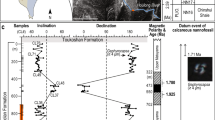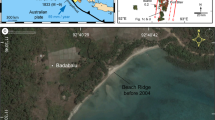Abstract
RATES of submergence of the northeastern seaboard of the US during the past several thousand years as determined from studies of coastal marsh deposits show considerable variation. The marshes became established on submerging shorelines and have grown upwards and landwards with the continued relative rise in sea level, thereby often forming thick deposits of peat. A series of radiocarbon dates taken at various levels in the marsh can be used to reconstruct the history of submergence. This letter presents a study of the relative change in sea level in southern Long Island, New York, over the past 8,000 yr, and shows that the changing rates of submergence have been an important factor in the initiation and continued development of the area's saltmarshes.
This is a preview of subscription content, access via your institution
Access options
Subscribe to this journal
Receive 51 print issues and online access
$199.00 per year
only $3.90 per issue
Buy this article
- Purchase on Springer Link
- Instant access to full article PDF
Prices may be subject to local taxes which are calculated during checkout
Similar content being viewed by others
References
Rampino, M. & Sanders, J. E. (in preparation).
Kumar, N. Ann. N.Y. Acad. Sci. 220, 245–340 (1973).
Caldwell, D. M. & Sanders, J. E. Geol. Soc. Am. Abstr. 5, 144–145 (1973).
Williams, S. J. Coast. Eng. Res. Cntr Tech. Paper, No. 76-2 (1976).
Redfield, A. C. & Rubin, M. Proc. Natn Acad. Sci. U.S.A. 48, 1728–1735 (1962).
Stuiver, M. & Daddario, J. J. Science 142, 941 (1963).
Newman, W. S., Thurber, D. L., Zeiss, H. S., Rokach, A. & Musich, L. Trans. N.Y. Acad. Sci. 31, 548–570 (1969).
Kraft, J. C. Bull. geol. Soc. Am. 82, 2131–2158 (1971).
Curray, J. R. in The Quaternary of the United States (eds Wright, H. E. Jr & Frey, D. G.) 723–735 (1965).
Sanders, J. E. & Kumar, N. Bull. geol. Soc. Am. 86, 65–76 (1975).
Mclntyre, W. G. & Morgan, J. P. Coastal Stud., Louisiana State Univ. 8 (1963).
McCormick, C. L. in Coastal Environment of Northeast Massachusetts and New Hampshire, 368–390 (1969).
Keene, H. W. Mar. Sedim. 7, 64–68 (1971).
Kraft, J. C. Ann. N.Y. Acad. Sci. 288, 35–69 (1977).
Belknap, D. F. & Kraft, J. C. J. Sed. Petrol. 47, 610–629 (1977).
Fairbridge, R. W. Science 191, 353–359 (1976).
Bloom, A. L. & Stuiver, M. Science 139, 332–334 (1963).
McCormick, C. L. in Guidebook to Field Excursions, 47th A. Mtg, NYSGA (ed. Wolff, M. P.) 51–72 (1975).
Author information
Authors and Affiliations
Rights and permissions
About this article
Cite this article
RAMPINO, M. Holocene submergence of southern Long Island, New York. Nature 280, 132–134 (1979). https://doi.org/10.1038/280132a0
Received:
Accepted:
Published:
Issue Date:
DOI: https://doi.org/10.1038/280132a0
This article is cited by
-
How Plants Influence Resilience of Salt Marsh and Mangrove Wetlands to Sea-Level Rise
Estuaries and Coasts (2021)
-
Barrier dynamics and landward migration with Holocene sea-level rise
Nature (1983)
Comments
By submitting a comment you agree to abide by our Terms and Community Guidelines. If you find something abusive or that does not comply with our terms or guidelines please flag it as inappropriate.



